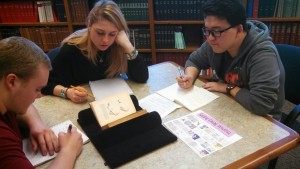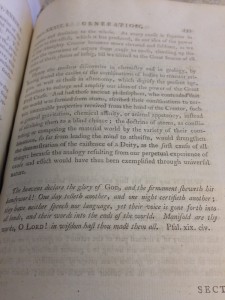The Wangensteen Historical Library of Biology and Medicine houses rare books dating from 1430 to 1930, along with a collection of written manuscripts and medical artifacts.
Historical libraries that offer glimpses into the past are treasures for historians, artists, and researchers, among others.
They stand in stark contrast to our daily lives, where information is pushed to us through digital technologies at every point in our day, only to be disposed of in the moment.

Students in Life on Earth: Perspectives on Biology class. Spring 2015. From left to right: Theodore Ernst, Madison Bolatto, and Ruiquan Li.
Emmie Miller, graduate student in the History of Science, Technology, and Medicine at the University of Minnesota, knows this first-hand. In a recent post in her departmental blog, she says, “One difficult thing about being an instructor today is the concern that students, distracted by their buzzing phones and binging Facebook apps, don’t care to learn because they’re preoccupied with what’s trending.”
Miller took this challenge and used it to her benefit by asking her students in her Life on Earth: Perspectives on Biology class to bring primary sources into the digital age. Miller’s vision, “instead of steamed-milk hearts in their lattes, their phones would be full of images of century-old texts, complete with a usable hashtag, #Wangensteen.”
Ultimately, Miller asked her students to pair images taken from historical texts and incorporate them into a blog post that detailed the significance of the work. What follows below is the first in a series of final projects that will be shared over the course of the next few weeks.
Erasmus Darwin: Zoonomia (1794)
by Nick Mielke, Diana Johnson, and Tracy Wimmer
Erasmus Darwin, born in 1731, was a poet, a medical physician, and a theorist of how organisms change over time. Most of Zoonomia, which was first published in 1794, is filled with various medical discoveries and theories that Erasmus Darwin worked on. For example, he had sections in Zoonomia dedicated to optics, circulation, and the effects of alcohol on different organs, among many other medical discoveries.
His theory about how organisms change over time contains aspects of God and nature. Erasmus theorized that God created all organisms with the ability to be self-improving. The environment would shape the certain characteristics that would be favorable for the organism, and these acquired characteristics would be passed on to their offspring. Over time, a permanent change to the organism would be made.1
The first image is a very simple picture: the word ‘banks’ in all black capital letters surrounded by a yellow circle. Despite its simplicity, the picture means much more to Mr. Darwin. In this section, Erasmus is discussing the complexity of the eye, specifically on the “variation of spectra in respect to their distance and size…”2 In this mini experiment, Erasmus looked at the ‘N’ in banks for one minute and then closed his eyes. He immediately saw the same image he was looking at. When he reopened his eyes, he looked at a white wall and was able to see the exact same picture on the wall, except at a larger scale.
While Erasmus could not exactly explain what was going on, he definitely noticed a significance in magnification and how the eye worked. While the precise significance of this one example is unknown, this was most likely a whole new way of understanding the complexity of the eye.
The articulation of this phenomenon could have impacted nineteenth-century science such as being a part of the watchmaker argument or indirectly having an impact on the first known camera, which was made much later. Erasmus Darwin contributed much to the medical sciences as well as the beginnings of evolutionary theory. Erasmus and his theories influenced many early scientists, including Erasmus’s own grandson, Charles Darwin.
The second image, taken from Zoonomia, contains a poem that Erasmus Darwin wrote in the Generation section of his book. Erasmus Darwin was a poet, and the large blocks of text in Zoonomia are broken up by these little poems. This poem in particular focuses on God and God’s creation. In the poem, Darwin acknowledges God’s handiwork and recognizes the breadth of God’s creation, “…gone forth into all lands… into the ends of the world…” (Darwin 533).
This poem represents Erasmus Darwin’s theory of evolution. He believed that God, or a divine creator, created all living organisms to be adaptable and strive for improvement. This improvement was usually determined by the environment, but it was Erasmus’s theory that there was a divine creator, regardless of the mechanisms of the adaption.
References
- Bowler, P. (2009). Evolution: The history of an idea (4th ed.). California: University of California Press.
- Darwin, E. (1794-1796). Zoonomia (Vols. 1-2). London: Printed for J. Johnson, in St. Paul’s Church-Yard.
About the Authors
Nick Mielke comes from Maple Grove, Minnesota. He is a junior in the College of Biological Sciences at the University of Minnesota, majoring in biology and taking a minor in psychology. With his degrees, Nick plans to go to medical school to get his M.D.
Diana Johnson is a junior biomedical engineering major. Diana hails from Minnesota, and when she finishes her degree, she hopes to get a job in one of the many biomedical companies in the metro area.
Tracy Wimmer, originally from Minnesota, graduated from the University of Minnesota in May of 2015. She earned her B.S. in Animal Science. A vocal participant in class, Tracy is now enrolled in the class of 2019 Veterinary Medicine at the University.






